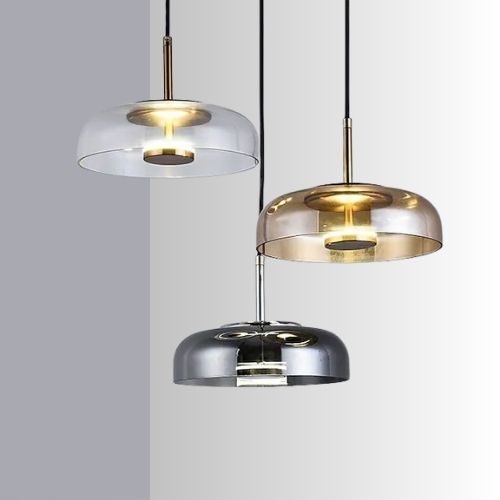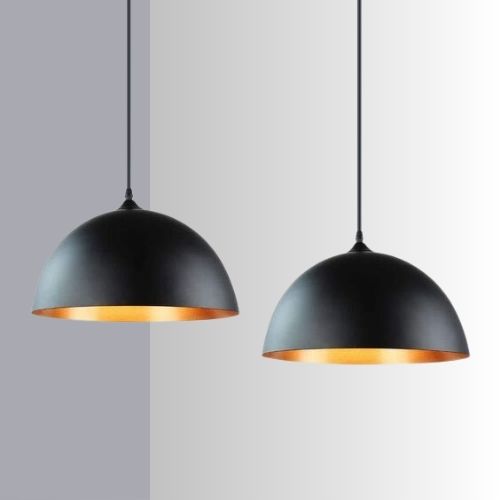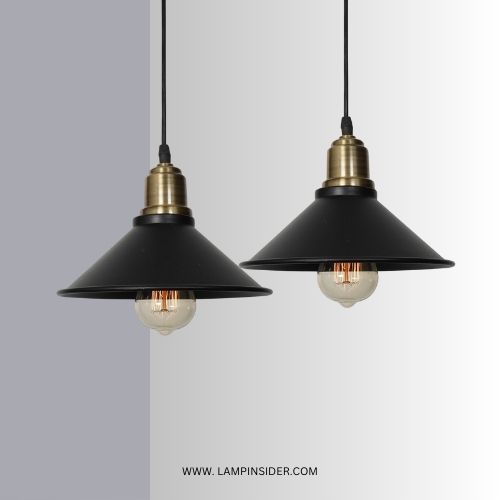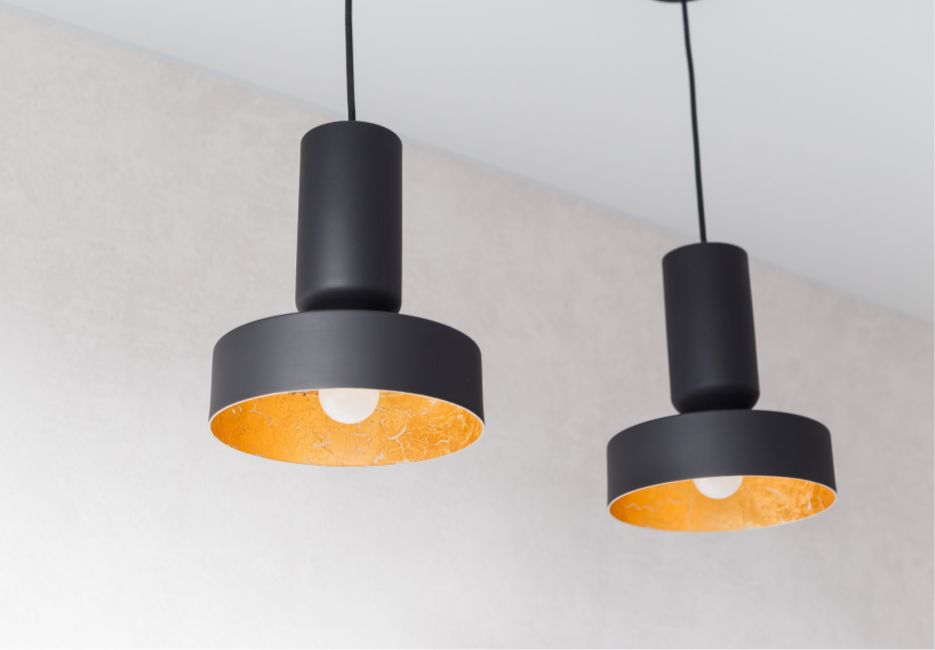A pendant light is a lighting fixture that is suspended from the ceiling using a chain, rod, or cord. It’s usually hanging from one point and has a downward-facing light source.
They are a wide and leading light source that you can use to carry out different purposes; this creates an interesting appearance and also enhances the function of the room. They come in a wide range of designs, sizes, and materials, making them suitable for different interior design styles.
Be it a focus decorative occasion or a spotlight activity, the pendant lights function as the general light and accent lights, respectively, and therefore are capable of providing both ambient and focused illumination.
The pendant lighting’s product design and position are the main elements that have the greatest effect on the space’s overall appearance and mood. It can create a warm, snug, and intimate environment or, alternatively, it can make the room breathtakingly beautiful and lavish.
All in all, pendant lights are a great addition to a living space when you want to provide both useful and decorative lighting at the same time.
The Various Styles of Pendant Lights
Pendant lights exist in countless designs to fit in the most preferable and appropriate environment where they correspond directly to every room. These include but are not limited to the following:
1. Modern and Contemporary Pendant Lights

These pendant lights are usually rectangular and circle-shaped which is similar to the geometric shape. These are glass, metal, or plastic materials. The blemished ones come from the Ouroboros center and repeated golf patterns are shown.
2. Industrial Pendant Light

Industrial pendant lights tend to be more rugged and practical, yet still hold a unique style of their own. They sometimes reveal the metal shades and the exposed bulbs as their major design points.
3. Traditional and Vintage Pendant Lights

These pendant lights are very different from the other two because they are mostly traditional. They include symmetry and the eight-pointed shape signifying cosmic harmony, also in Decadent Abbey-Oaks, the design of a several-pointed fire sunflower.
A vital measurement to make when selecting the pendant lighting style is the current decoration and design theme of your area. Choose a mode that functions as an enhancing element of the entire visual environment and enriches the mood.
The Difference Between Pendant Lighting and Hanging Lights
While pendant lighting and hanging lights seem like they are the same, there are a few main differences between the two. Pendant lighting is a type of light fixture that is suspended from the ceiling by a rod, chain, or cord and usually has one light source that hangs down. These lights are often used for both functions and aesthetics, thus they are part of the style and atmosphere of a place.
However, hanging lights are a larger category that comprises any type of light fixture that hangs from the ceiling. This may be things like chandeliers, lanterns as well as most types of ceiling-mounted lights. Hanging lights may have multiple light sources and also have a larger and more detailed design as compared with pendant lights.
| Aspect | Pendant Lighting | Hanging Lights |
| Definition | Single light fixture hung from the ceiling, focusing light on specific areas like floors or tables. | Any light fixture hung from the ceiling that creates ambient illumination. |
| Design Variety | Large number of shapes, styles, and sizes. | Includes recessed lighting, tracks, chandeliers, sconces, with various subtypes. |
| Common Uses | Overhead lighting for dining and dinner tables. | General light sources like chandeliers, lanterns, and multi-light fixtures. |
| Installation | Usually requires electrical work and fasteners. | Can range from simple plug-ins to complex installations involving drilling and hardware. |
| Materials | Glass, metal, plastic, fabric. | Wood, metal, glass, crystal, fabric, plastic. |
| Light Source | Mostly uses one light bulb. | Light sources vary based on materials like glass, metal, fabric, and polymers. |
| Style | Available in contemporary, vintage, traditional, and industrial designs. | Includes traditional, modern, vintage, and eclectic styles. |
| Adjustability | Height can often be adjusted. | Some products are adjustable, while others are fixed. |
| Cost | Price is determined by design and material. | Cost varies widely depending on design and materials. |
| Energy Efficiency | Often compatible with LED bulbs, affecting energy consumption. | Energy consumption depends on the type of light bulb used. |
| Maintenance | Simple to clean and maintain. | Maintenance cost varies based on style and material. |
| Ambiance | Can focus light on specific areas or disperse it throughout the room. | Can create a wide range of lighting patterns, depending on design and material. |
In short, pendant lights are the type of hanging light that consists of a single light source and has a downward-facing design. They are flexible and can be found in many different models, sizes, and materials to match the needs of different interior design styles. Nonetheless, there are hanging lights that are more general with chandeliers lanterns, etc. Among the hanging lights family. These lights are available in various sizes, styles, and functions too.
How to Choose the Right Pendant Light for Your Space?
Picking out the right pendant light for a space entails analyzing multiple aspects. Here are some important tips to think about to make the right choice:
Find Out the Purpose: Decide whether you want the pendant light to offer ambient, task, or just aesthetic lighting. This will clear up the sizing, brightness, and the place where the light should be installed.
Set the Size: Think about the size of the room and the height of the ceiling when selecting the right light. A larger pendant light in a small room will be too dominant, whereas a smaller one may be barely noticeable when it is placed in a large open space.
Get the Style Right: Your space decoration and overall theme need to be considered here. Go to the pendant light that is both the best match for the general look and adds visual interest.
Don’t Forget the Suitable Height: Think about the level at which the light is to be flown. The light must be so placed that it makes the area bright enough without completely covering it or making it terribly bright.
Consider the Bulb Type: Choose either LED, incandescent, or halogens and take the advantages of each type into consideration including energy efficiency, brightness, and color temperature.
How to install Pendant Lighting Tips
To set the pendant light well you need both careful planning and execution. Providing guidance that contains the following along with proper wiring for installing the fixture is the main idea here:
Step 1: Measure and Mark
Before installing the pendant light, you should first measure and mark the spot on the ceiling where you want it to be. To find the ceiling joists and the structural supports, you should use a stud finder.
Step 2: Turn Off the Power
Stop the power before venturing into any electrical work. This will see to it that you are not at risk.
Step 3: Read the Instructions
The first thing you need to do is read the manufacturer’s instructions and have a good understanding of the installation process ahead of time. In this way, you will make sure the pendant light is uploaded from a position that is not dangerous and is held securely.
Step 3: Include the Right Tools
For installation purposes, use the necessary tools including a drill, a screwdriver, and a wire stripper. Such tools will make the process the easiest and the safest.
Step 4: Get a Specialist
In case you have any questions regarding any of the installation steps, you need to work with a professional electrician.
If you memorize the above guidelines and put them into action, you will have a profitable and secure pendant light installation.
List of the Preferences of Pendant Lighting Inside the House
One of the essential needs is to include pendants as lighting tools in the room. The benefits of pendant lighting are so many and some of them include the following:
- Adds Visual Interest: Pendant lights, which are unconventional in that they have an artistic element, add eye-catching appeal to a room. They are available in many different forms, colors, and materials, so there is a possibility to have a pattern that is ageless and complements
- Creates Ambiance: The use of pendant lights can assist in creating a specific atmosphere or mood in a place. For example, dimmable pendant lights can be adjusted to create a cozy and intimate atmosphere.
- Highlights Focal Points: Pendant lights can be a highlight or main element of the space or object in a room. For example, a pendant light put above a dining table can properly concentrate the observer on the table and establish a primary point.
- Provides Task Lighting: Pendant lights are the best sources of task lighting, as they shine light down on the specific tasks at hand. They can be installed in areas that are frequently used for work, such as kitchen islands, countertops, or desks, to light them up.
- Maximizes Space: The lights are fixed to the ceiling so that they do not require the floor or any of the surfaces to operate. Thus, they are the best choice for housing small rooms or places with limited space.
- Finally, pendant lighting serves as both the one responsible for functional illumination and ambiance.
FAQs
Q: Can pendant lights be used in outdoor spaces?
A: Despite the fact that traditionally pendant lights are indoor lighting, there are also outdoor-rated pendant lights on the market. These pendant lights can be used in a covered outdoor space. However, manufacturers’ specifications should be checked and it should be made sure that the outdoor use of pendant light is actually permitted.
Q: How do I clean and maintain pendant lights?
A: To clean the pendant lights, turn off the power first and let the light cool down. Now you can use a soft dry cloth to remove the dust and dirt from the surface of the light fixture. If necessary, use soap water, and a soft brush for a deeper cleaning. Regular maintenance is the key to keeping your pendant lights shiny.
Q: Can pendant lights be dimmable?
A: Yes, there are a number of pendant lights that are compatible with dimmer switches, which let you choose the light you want to have. They are also a source of the different lighting they produce. You should find the product specification or seek advice from a lighting specialist for compatibility with dimmer switches.
Q: Are pendant lights energy-efficient?
A: Pendant lights have the potential to be energy efficient when they use the right bulbs. LEDs are the most sought-after bulbs for their ability to save a lot of energy and for their longer life. Putting up LED bulbs along with other energy-saving practices can help you decrease the amount of power you use and keep your electricity bill down.
Q: How do I determine the right height for hanging pendant lights?
A: The right hanging height for the pendant lights is subjective to the purpose of the light and the dimensions of the space. Preferably, pendant lights should be hung ensuring not only that the space is well-lit but that the space remains open. Typically, the height of the pendant lights that are illuminated over a dining table should be about 30 to 36 inches.

Rowena Mitchell is a Lighting Expert at Lamp Insider, known for her innovative approach to lighting design. With a solid foundation built at GE Lighting, Rowena brings a wealth of experience and a keen eye for detail to every project she undertakes.
